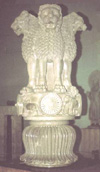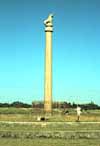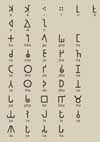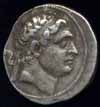| x |
|
 |
==Ashoka
Maurya (r.c.268-c.233 BCE): Chandragupta's grandson,
becomes
the greatest Maurya king and an effective Buddhist proselytizer (*wiki*).
Conquered by ferocious fighting, his realm includes-- though in a
swiss-cheesy
way (*F.
Smitha*)-- most of India (except the extreme south) and extends
northwest
through the whole northeastern part of Afghanistan: *the
Mauryan Empire**. He does a stint
as
governor in Gandhara before becoming king, and his reign shows Greek
and
Persian cultural influences. [*Routes*] |
 |
==Ashoka's
famous pillars: The dozens of
animal-topped
pillars (*DSAL*)
that Ashoka erects (or in some cases inherits from predecessors and
re-inscribes)
in India, Nepal, Pakistan, and Afghanistan are conspicuously influenced
by those of Persepolis (*Univ.
of Chicago*). On them, and on rocks, he carves his edicts: *access
to insight*. [*Routes*] |
 |
==The
first written records in South Asia: Ashoka's
inscribed rocks and pillars are the first South Asian writing that we
have.
His main language is Magadhi Prakrit, though on some northwestern
pillars
he uses Aramaic (the official language of the Persian empire) and even
Greek. His main script is Brahmi (*ancient
scripts*; *omniglot*),
which becomes the ancestor of the main Indian scripts and many
Southeast
Asian
ones (*Eden
Golshani*); but he also sometimes uses Kharoshthi (*ancient
scripts*). |
 |
==the
Barabar cave-temples (c.260) are cut by early Buddhists
into
the hills near Pataliputra (modern Patna); among them, "Lomas Rishi
Cave"
is the first one that introduces architectural patterns that later
become
common (*DSAL*).
[*Routes*] |
 |
==the
Greco-Bactrian kings (c.250-50 BCE): Under Seleukos's
grandson,
the Seleukid Empire begins to face rebellions. On its eastern border, a
*Greco-Bactrian
Kingdom* (*grifterrec*)
takes shape, holding power for two centuries in Bactria (Balkh) and the
region of Afghanistan and northern Pakistan. More on such east-west
connections:
*Intercourse
between India and the western world from the earliest times to the fall
of Rome*, by H. G. Rawlinson [*Routes*] |
 |
==the
Mahabharata: Scholars differ on when the earliest strata
of the great Indian epics begin to develop; the best current consensus
seems to be around this time if not before, with the Mahabharata
possibly
somewhat the earlier of the two: *Columbia
Univ.* In its earliest forms, it seems not to have included the
"Bhagavad
Gita"; *the
India of the Mahabharata*. [*Routes*] |
 |
==the
Ramayana: The earliest strata of this great Indian epic
begin
to develop: *Columbia
Univ.*. Its development continues to the present, with new stories
constantly being told that provide fresh slants on the older material.
Nowadays Rama is still a perfect hero and ideal king to some Indians,
but
that's no longer a universal opinion; *the
India of the Ramayana*. [*Routes*] |
|
|








